Following the leaked images from earlier this week Volkswagen has released official information about the new Golf VI. The images have also been released in higher resolution and 2000px super images can be accessed by clicking on the images in this article.
As expected the importance of the new Golf has not been lost by Prof Dr Martin Winterkorn, Volkswagen AG Chairman, and he claims the VI will raise the bar again for its market segment, “This sixth generation of Golf cars will completely redefine the quality and comfort level of its class over broad categories, offering more customer value than ever before.â€
Volkswagen says fuel consumption across the board has been reduced by up to 28 per cent, with emissions now meeting Euro-5 standards. New technologies, such as automatic distance control and park steering assistant have been introduced. Revised ESP systems help increase safety capabilities, along with seven-aribags and daytime running lights as standard. Volkswagen also says big improvements have been made to reduce interior noise through the likes of new door seals, special windscreens and reworked wing mirrors.
Revised diesel engines will now use common rail injection and all diesel Golfs will be fitted with a particulate filter. Petrol powered engines have reduced fuel consumption, with all engines at launch having quoted consumption figures under 6.5l/100kms (with the exception of the normally aspirated 1.6-litre at 7.1l/100km). Conventional automatics have been completely replaced with re-worked DSG trasmissions.
While stating the bleeding obvious, the Golf is Volkswagen’s most important model, and the aim with the VI is to reduce manufacturing costs over the previous Golf V. The necessity to do this brought the release of the Golf VI forward by around two years and it remains to be seen if the measures put in place by Volkswagen will achieve their ultimate aims. They will certainly sell plenty of them, they just need to hope their return on investment meets their expectations. One could consider this more of a Golf V.5, rather than a completely new model, however, Volkswagen knows they cannot afford to drop the ball with the Golf and the changes and improvements made appear to be a step in the right direction. Some consider the styling of the Golf to be boring and unimaginative, although, as an unabashed fan of teutonic design, the more I look the Golf VI the more I begin to appreciate the revisions made. The more angular and sharper look is a solid improvement over the Golf V.
So far, at least, the Golf VI has the AUSmotive seal of approval. I can’t wait to get behind the wheel. Barring any unforseen overseas junkets, that will have to wait until around this time next year when the Golf VI is expected to be on sale in Australia. The Golf VI GTI should arrive here sometime before July 2010.
Full details of Volkswagen’s release, along with more images, can be viewed after the jump.
Update 15 January: Expect the Golf VI to have its Australian launch at the Melbourne International Motor Show (27 February–9 March).
Volkswagen Unveils Sixth Generation of Iconic Golf Model
- Golf’s high levels of value and comfort nullify class distinctions
- New Golf design points the way to Volkswagen’s future
- TDI, TSI and DSG systems improve fuel economy by up to 28 percent
- First Golf with adaptive chassis and automatic distance control
Wolfsburg, August 2008. Volkswagen is unveiling its most important automotive secret of the year: the new Golf. The car – Europe’s most successful with more than 26 million sold – was improved in all areas. “This sixth generation of Golf cars will completely redefine the quality and comfort level of its class over broad categories, offering more customer value than ever beforeâ€, says Prof. Dr. Martin Winterkorn, Chairman of the Board at Volkswagen AG. The European market launch of the new Golf will begin in October; following in succession will be Africa, Asia, Australia and North America. The entry price for the German market is around 16,500 Euros.
Innovative power – the Golf democratizes progress
The clear and powerful design of the new Golf is showing the entire brand the way to the future. Its acoustic properties and the overall comfort of the Volkswagen tear down class distinctions. Innovative engines and transmission technologies lower fuel consumption by up to 28 percent. All petrol and diesel engines satisfy limits of the future EU-5 standard.
Assistance systems such as “automatic distance control†(ACC), “adaptive chassis control†(DCC) and the “park steering assistant†bring additional top technologies on board the Golf. A new ESP system, with finer response over its control range, further optimized crash properties, seven airbags including knee airbag, the special head restraints that counteract whiplash trauma, a “seatbelt detection†feature debuting in the rear seating area of the Golf and daytime running lights – that are standard equipment – provide for a maximum level of safety.
Exterior design – Precision in a new form
The high value of the new Golf is reflected par excellence in its stylish design; all key body elements were redesigned: “We have cast the Golf’s core components in a precise, new moldâ€, explains Walter de Silva. And the Italian design chief of the German corporation emphasizes this: “The Golf is the global icon car making. So the architecture and graphic form of new model are also absolutely clear and unique.†At the same time, the sixth Golf has a sportier and more distinctive appearance than any previous generation of the model series. De Silva: “It is more accentuated, more three-dimensional than its predecessor; with precisely defined lines and edges, and with finely proportioned flared surfaces and recesses.†And Klaus Bischoff, Chief Designer for the Volkswagen brand, adds: “Every detail is uncompromisingly aimed at improving value.â€
Especially in a direct comparison of generations five and six, it becomes clear just how much the new Golf has changed. The team headed up by de Silva and Bischoff sought to crystallize out the “essential DNA†of the model series and send it on a trip to the future. These stylistic characteristics include the clear front end of the first generation and the C-pillar that was perfected in the fourth generation.
The roof section now rests – similar to the new Scirocco – on a dominant filled out shoulder section. Responsible for this is a prominent curving line that – like a muscle trained down to the last fiber – extends from the headlights back to the taillights. In its side profile, this line – which Volkswagen Design calls the “character line†– also gives the new Golf a fuller, lower stance on the road from a side perspective.
All body surfaces are generally more relaxed, more athletic. In front the new car takes up the horizontally aligned radiator grille trim strip between the headlights of the first Golf generation; the grille itself is high-gloss black. The lines of the bumper match those of the radiator grille. Beneath this is an adjacent section with another air scoop. Also arranged on a black background are the chrome light housings of the dynamically styled headlamps.
In the rear too is characterized by a dominance of horizontal lines. The taillights – very wide now – are identified among other things by an unmistakably unique night design. Stylistically – with their crystal-clear lines for the turn signal and backup lamps – they bear a resemblance to the taillights of the Touareg. Overall, the image of the new Golf – in the interplay of all of its design characteristics – is one of a significantly wider, flatter and even more high-end car.
Interior – imploding class distinctions
The car’s exceptional value also applies to the newly designed interior, whose refined surfaces and features completely transform class distinctions, both to the touch and visually, especially in the cockpit area. The appearance and layout of materials and details such as brushed chrome accents and round instruments derived directly from those of the Passat CC leave the impression that one is actually sitting in a car of the next higher segment. Ergonomic properties of the car’s interior were also further developed. For example, all operating controls are even easier to use. They include the control of the automatic climate control system (Climatronic) – presented for the first time on the Passat CC – and the power window controls that are now located further forward in the door trim, making them easier to access.
There is a common thread here: Volkswagen’s typical attention to perfection of every detail in the car. Take the example of “seatbelt detection†in the rear: if the Golf is ordered with rear side airbags, the user can recognize on the multifunctional display in the cockpit whether the occupants have their seatbelts fastened in the rear – separately for each seat. Or take the example of leather seats: a new, more robust leather surface is being used. Or the example of the cargo area: four practical hooks ensure that after shopping, the contents of shopping bags are not strewn across the cargo area. Or the example of the outside mirrors: thanks to an aerodynamically optimized shape they get significantly less dirty. They are easier to adjust from the interior, since the power mirror adjustment control is now located further up and more forward in the door trim.
Noise reduction – the quietest Golf since the first model
The new Golf is characterized by first-class acoustic properties. A special damping film in the windshield also reduces driving noises, as does the newly developed seal concept for the doors and side window guides. The new shape of the outside mirrors also significantly reduces wind noise. Furthermore, special modifications were made to acoustically isolate the engine and passenger compartments from one another better. Very quiet rolling tires and new engine bearings round out the noise reduction package.
Diesel engines – migration to common rail injection
Making a significant contribution to the pioneering acoustic properties are the exceptionally quiet TDI common rail engines being used in the Golf for the first time. Two balancer shafts also put an end to undesirable vibrations. Plans call for a TDI power range extending from 66 kW / 90 PS to 125 kW / 170 PS. Right at the market launch, Volkswagen will be offering the Golf with two 2.0 litre TDI engines; they output 81 kW / 110 PS and 103 kW / 140 PS. Always there as production equipment: a diesel particulate filter (DPF).
The new TDIs are exceptionally fuel efficient. The 110 PS strong entry-level diesel is satisfied with 4.5 litres of fuel (119 g/km CO2) per 100 kilometres – that represents a 0.6 litre reduction! Even the 140 PS version only requires 4.9 liters of diesel (129 g/km CO2), which is 0.6 litres less.
Gasoline engines – more economical than ever before
Four variants will define the range of petrol engines in the launch phase: 59 kW / 80 PS, 75 kW / 102 PS, 90 kW / 122 PS and 118 kW / 160 PS. Starting at 90 kW / 122 PS, the TSI engines come with supercharger and/or turbocharger. The fact is that the petrol engines too are pioneering when it comes to fuel economy. The optimized 80 PS entry-level engine consumes just 6.4 litres of premium unleaded petrol (98RON) per hundred kilometres (149 g/km CO2) – that is 0.5 liters less than the previous model. The other TSI engines are also taking the stage as prime examples of efficiency: at 122 PS the new Golf 1.4 TSI consumes just 6.2 litres of premium unleaded petrol (98RON) per hundred kilometres(144 g/km CO2); this yields a fuel consumption advantage of 0.1 liters. Even the new 160 PS top version of the 1.4 TSI attains an excellent value at 6.3 litres. Compared to the retired 150 PS FSI, the 160 PS TSI’s fuel consumption was even lowered by 1.6 litres.
DSG – replaces conventional automatic
With the exception of the entry-level versions, all petrol and diesel engines can be paired with Volkswagen’s dual clutch transmission (DSG). Depending on the engine torque, either a 6-speed or 7-speed DSG is used. On the Golf, the extremely efficient and agile DSG has thereby replaced the classic torque converter automatic. Just how efficient the alliance of TSI plus DSG can be is demonstrated by the average fuel consumption of the 1.4 TSI with 160 PS and 7-speed DSG: 6.0 litres (139 g/km CO2). This high-tech duo replaces the 2.0 FSI with 150 PS and 6-speed automatic.
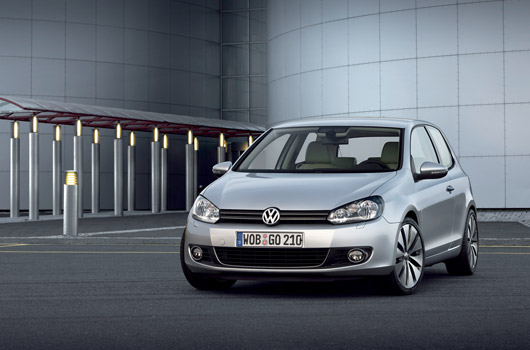
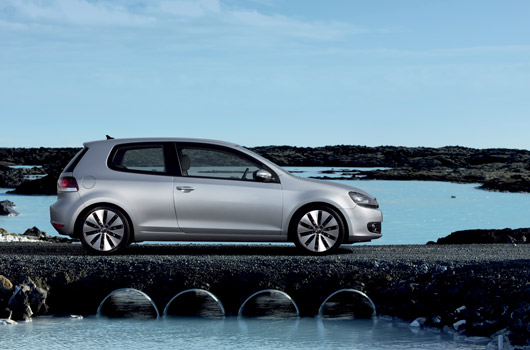
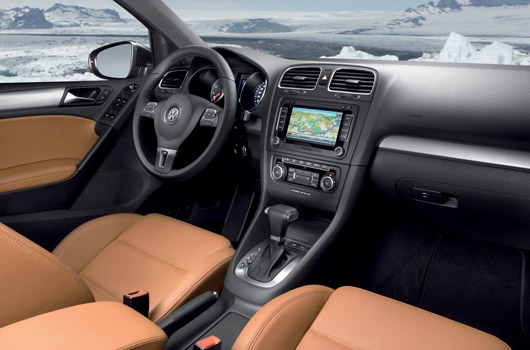
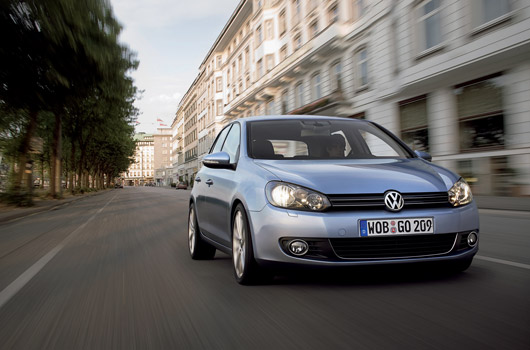
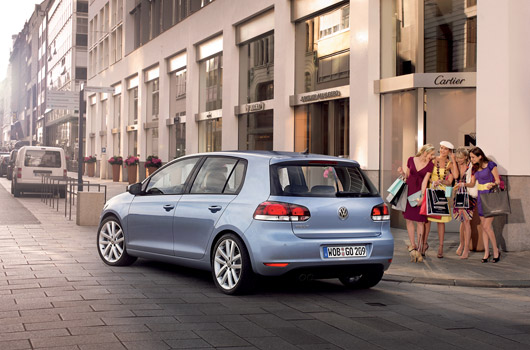
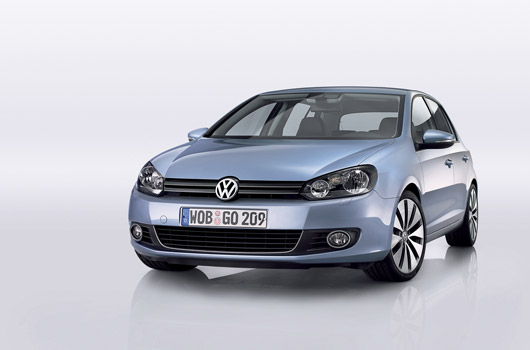
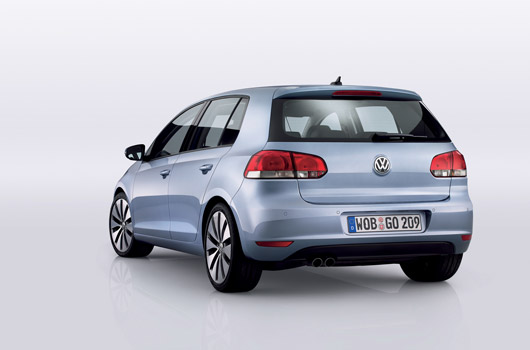
18 replies on “Yes, this is the new Golf VI!”
Who will buy a scirocco now the golf mkvi looks like it?
Also the picture from the back on the street the car has wheels that aren’t from robocop and then look pretty good!
Also the scroll wheels on the steering wheel will be good.
The current A3s have the scroll wheel on the steering wheel. It’s a bit funny after the buttons on the Golf, but they are quite good once you get used to them.
Although, just looking at the large version of the interior pic again, the buttons still look like buttons, with a mobile phone style arrangement around a central button. On the left it looks like the phone button, and on the right is the OK button.
you’re right they are arrows. still they will probably work well.
um, where is the centre vent for the Climatronic? I love my draftless A/C.
And the key doesn’t look ‘keyless’ either
The humble Commodore Omego also has a scroll wheel
I mean Omega amigos! Can I edit my own comment here?
Dunno about that?
Currently running WordPress 2.3.x and they’re about to launch 2.6 I think. I’m too scared to upgrade in case I stuff up some of my extra plug-ins, haha. But it may be that user comment editing is available in the newer versions?
[…] the release of details for the Golf VI comes news that a GTI prototype could be revealed as soon as October this year. It is expected a […]
[…] Golf VI GTI has been spied in testing. With the recent release of information on the broader Golf VI range only the front grille and rear light/bumper treatment has been covered in this test mule. You can […]
[…] official images and details of the new model Golf have been released, the official launch of the Golf VI is yet to come. […]
[…] Volkswagen’s recent release of Golf VI information, internet leaks from last week have forced Renault’s hand into releasing images of their new […]
[…] the regular Golf VI range the new GTI has taken an evolutionary approach with a minor reworking of the front grille treatment […]
[…] new Volkswagen Golf VI recently achieved 36 from a possible 37 points in Euro NCAP occupant protection crash testing. This […]
[…] BMW 1 Series Coupé and the Volkswagen Golf VI have both joined Audi’s Q5 in the Golden Steering Wheel winners circle. The Golden Steering […]
[…] you enjoy this advertisement for Volkswagen’s upcoming Golf VI. Already released in Europe and the UK, it is due for Australian release sometime around the middle […]
[…] more on the new Golf, check out this previous AUSmotive post, including the Trackback links at the bottom of the article that will take you to a wide range of […]
Bump for the Melbourne Motor Show launch tip. 😉
[…] news on the official launch for the Golf VI as it comes to hand. In the meantime, check out this earlier post on the Golf VI which includes more images and information released last August prior to the car’s […]
[…] For more information on the new Golf read this earlier AUSmotive entry: Yes, this is the new Golf VI! […]